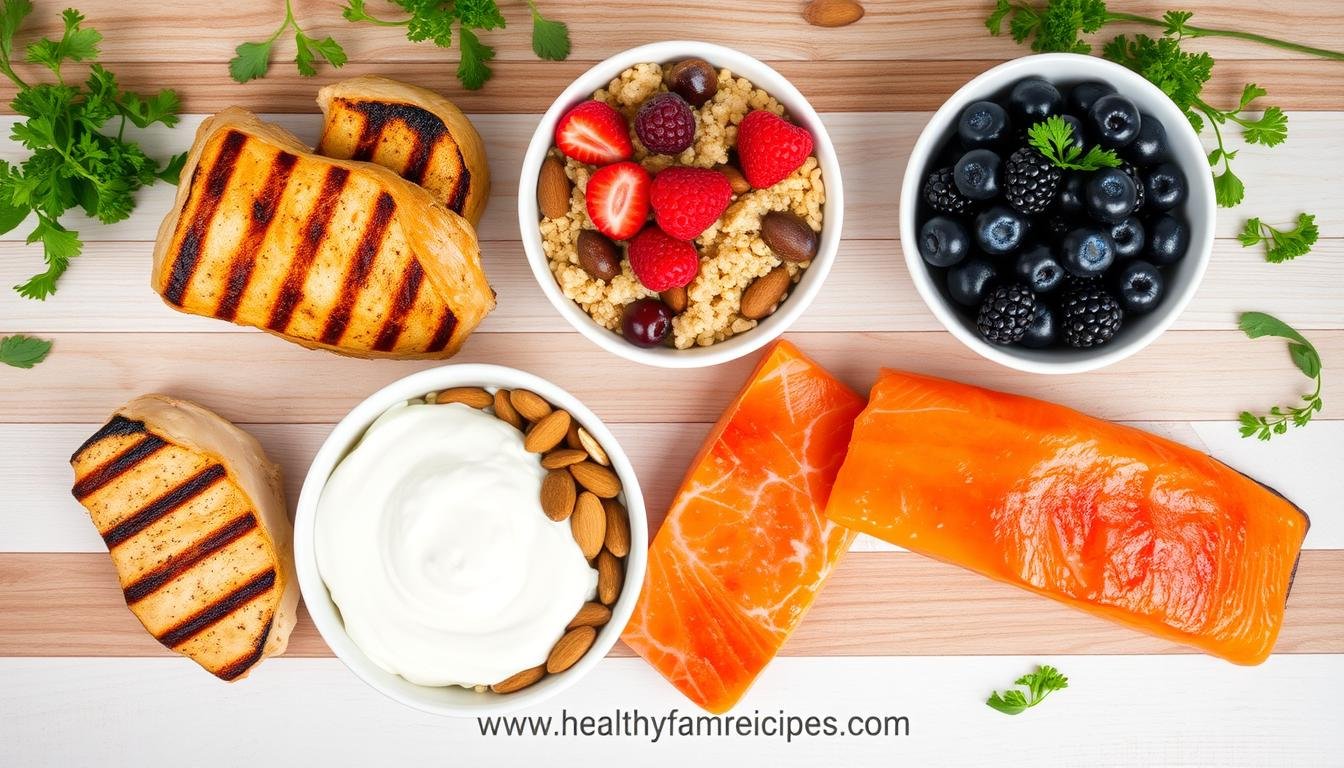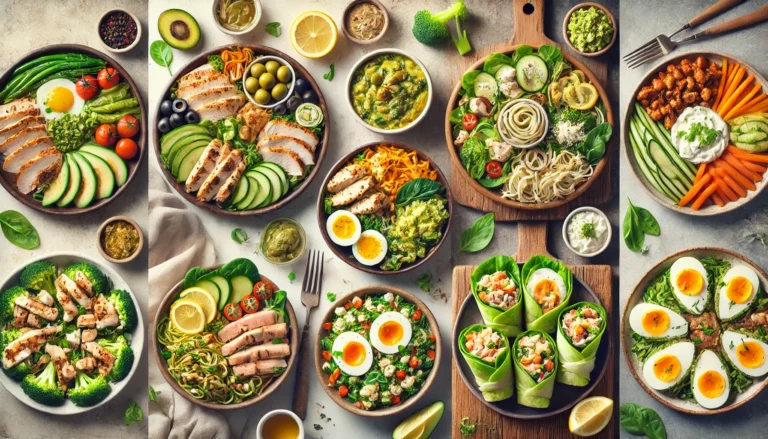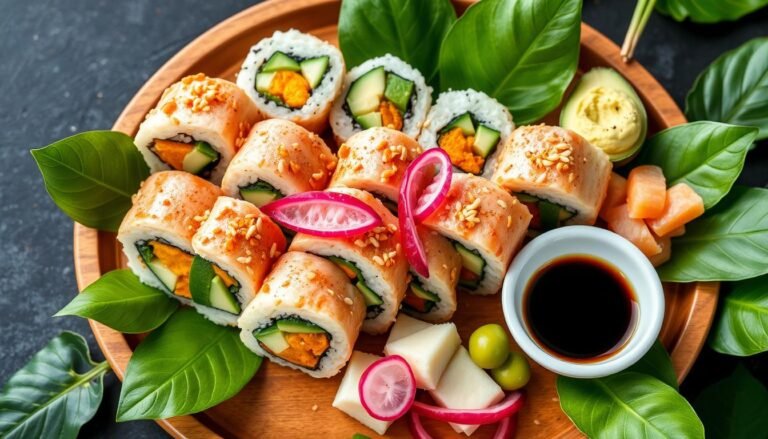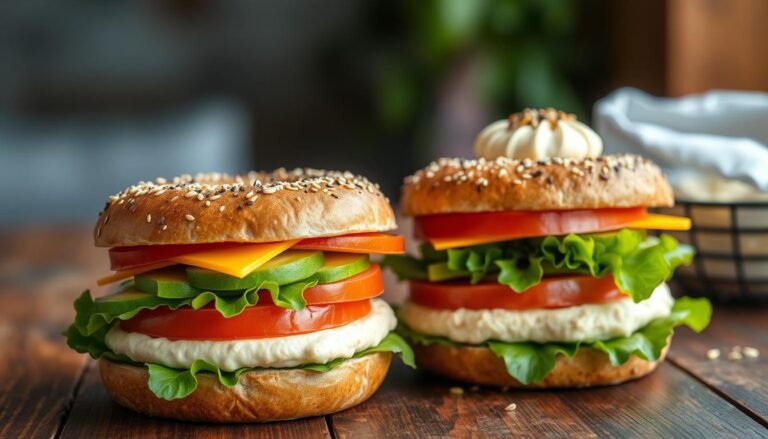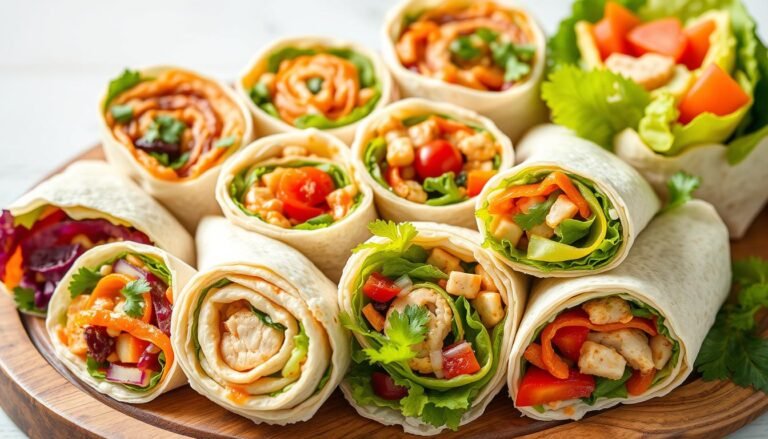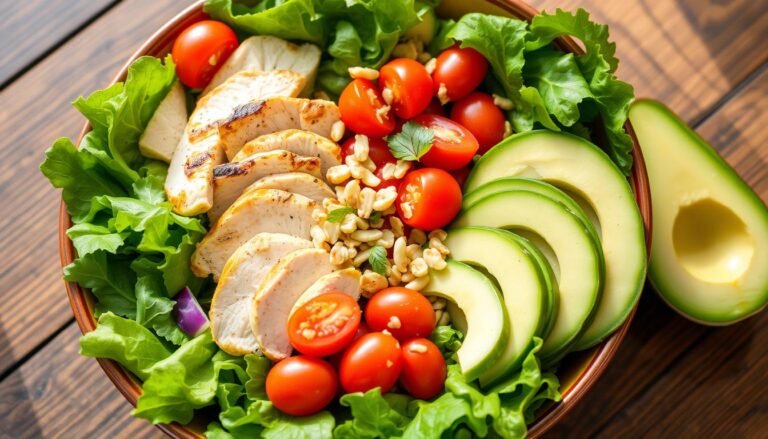Protein-Packed Choices: 5 Remarkable Snacks Under 200 Calories
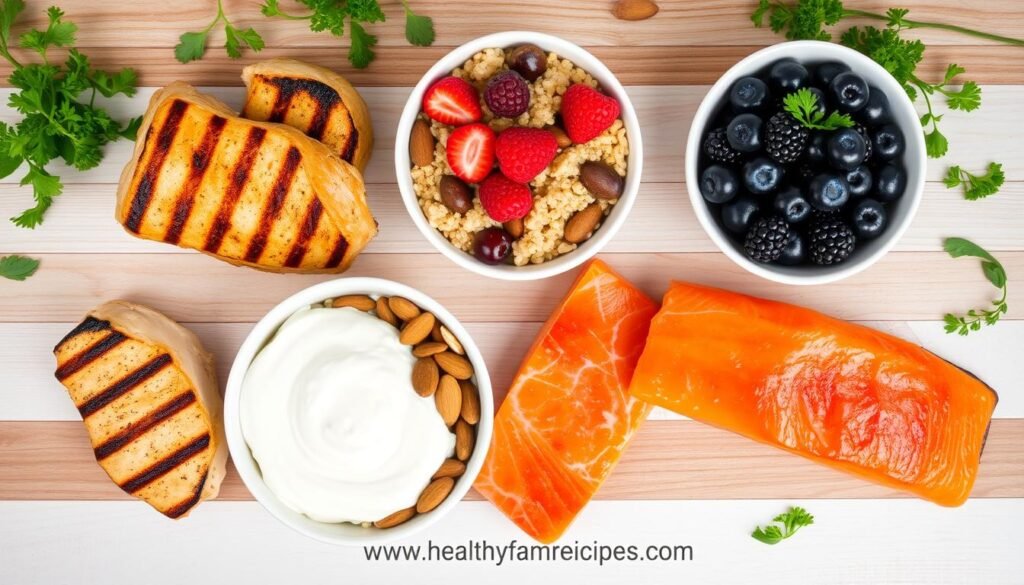
Table of Contents
Ever felt that mid-afternoon crash where energy plummets and motivation vanishes? Your body is sending a clear signal: it needs premium fuel. Protein-packed choices aren’t just nutrition—they’re your personal performance upgrade. They transform how you think, move, and conquer your day.
Muscle-building nutrition goes beyond simple eating. It’s about strategic choices that power your body’s potential. These protein-packed choices aren’t just foods; they’re your secret weapon. They fuel sustained energy, muscle recovery, and overall wellness.
Understanding what your body truly needs can revolutionize your approach to nutrition. From quinoa’s complete protein profile to Greek yogurt’s nutrient density, these high-protein foods are designed to optimize your physical and mental performance.
Key Takeaways
- Protein-packed choices support muscle growth and sustained energy levels
- Strategic food choices can dramatically improve overall health
- Diverse protein sources offer unique nutritional benefits
- Balanced protein intake helps regulate metabolism
- Quality matters more than quantity in protein consumption
Understanding the Importance of Protein-Packed Choices
Protein is key to a healthy diet for fitness. It helps repair muscles and keeps you well. Knowing how important protein is can change how you eat and exercise.
Experts say adults should eat 0.36 grams of protein for every pound of body weight each day. If you’re active, you might need more. They suggest eating 10% to 35% of your daily calories as protein.
Daily Protein Requirements for Optimal Health
- Recommended daily protein: 0.8 g/kg for adults
- Protein needs increase for:
- Growing children
- Pregnant women
- Physically active individuals
- Example calculation: 150-pound person needs about 54 grams of protein daily
Benefits of Protein-Packed Choices for Body Function
Lean protein sources are vital for your body’s best performance. They boost your immune system, make important enzymes, and carry nutrients.
| Protein Source | Protein per Serving | Additional Benefits |
|---|---|---|
| Chicken Breast | 31g per 100g | Low fat, high protein |
| Eggs | 6g per large egg | Rich in vitamins |
| Greek Yogurt | 17g per 6oz | Probiotics included |
Role of Protein in Muscle Recovery
After working out, eating protein is crucial for muscle repair and growth. Eating protein within 30 minutes after exercise helps fix muscle tissues and speeds up recovery.
“Protein is not just food, it’s the building block of your body’s performance and recovery.” – Sports Nutrition Expert
Too much protein can harm your kidneys. Always talk to a doctor to find out how much protein you should eat based on your health and fitness goals.
Protein-Packed Choices for Maximum Nutrition
Finding the best protein-packed foods can change how you build muscle. The National Institutes of Health says proteins have 20 amino acids. These are key for our bodies to work right.
“Nutrition is the foundation of health, and protein is its cornerstone.” – Nutritional Science Insight
Starting your high-protein journey means learning about different food sources. Here are some top picks to boost your diet:
- Lentils: A powerhouse providing 18 grams of protein per cooked cup
- Quinoa: A complete protein source with all essential amino acids
- Greek Yogurt: Offers up to 15 grams of protein per serving
- Chia Seeds: Compact nutrition with 5 grams of protein per ounce
- Almonds: Deliver 6 grams of protein per ounce
A 2024 study in The American Journal of Clinical Nutrition found protein is key. It helps keep muscle and brain sharp. Your protein choices are very important.
If you’re into building muscle, mix these protein sources. Try lentils with quinoa or chia seeds on Greek yogurt. These meals are packed with nutrients and support your fitness goals.
Lean Meats and Fish: Complete Protein Sources
Choosing the right lean protein sources can change your diet and help you reach your health goals. The American Heart Association suggests 10-35 percent of your daily calories should come from protein. This makes picking the right proteins very important for staying healthy.
Foods like fish and lean meats are full of protein but low in fat. The USDA says lean proteins have less than 10 grams of total fat and 4.5 grams or less of saturated fat per 100 grams.
Best Fish Options for protein-packed choices
Fish is a great choice for low-carb protein. Here are some top picks:
- Salmon: 17 grams of protein per 3-ounce serving
- Cod: 19.4 grams of protein per 3-ounce serving
- Canned light tuna: 19 grams of protein per 100 grams
- Tilapia: A virtually pure protein white fish
Selecting Quality Lean Meats
For healthy snacks and meals, try these lean meats:
- Skinless chicken breast: 36 grams of protein per small serving
- Turkey breast: 25.6 grams of protein per 3-ounce serving
- Extra-lean beef: 23.5 grams of protein with minimal fat
- Pork tenderloin: A lower-saturated fat alternative
Portion Control and Preparation Tips
“Quality matters more than quantity when selecting protein sources.”
To get the most nutrition, control your portions and cook healthily. Grilling, baking, and steaming are good ways to cook lean proteins without extra fats.
Pro tip: Aim for 3-4 ounce servings of lean proteins to maintain balanced nutrition and support your fitness goals.
Plant-Based Protein Powerhouses
Looking for vegetarian protein alternatives that pack a nutritional punch? Plant-based proteins are your ultimate high-protein food solution. These protein-packed choices offer incredible benefits for anyone seeking to diversify their diet and boost nutritional intake.
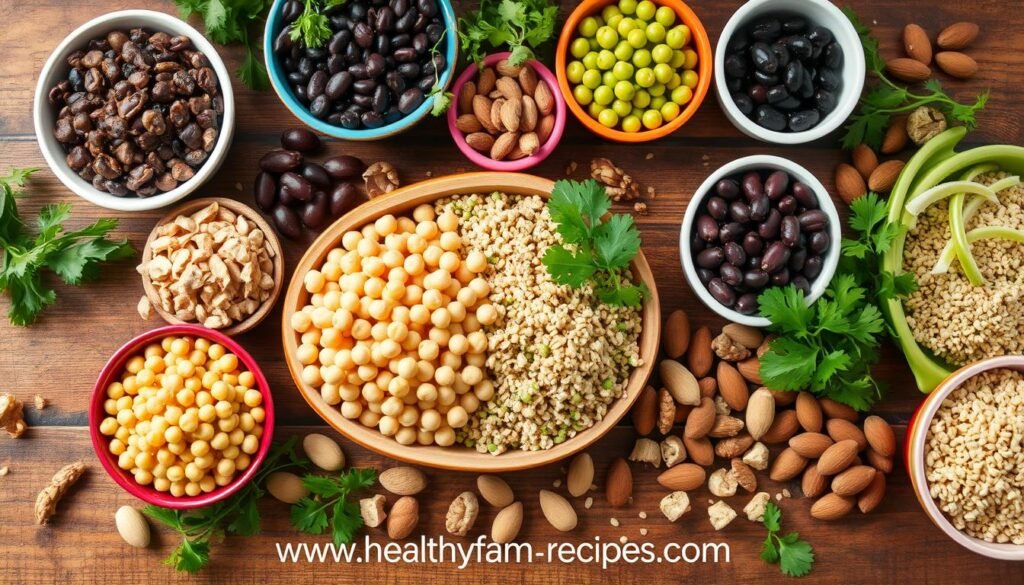
Discover the top plant-based protein sources that can transform your meals:
- Tempeh: Delivers an impressive 34 grams of protein per cup
- Lentils: Provides 18 grams of protein and essential iron
- Tofu: Offers 20 grams of protein per cup with low FODMAP content
- Chickpeas: Contains 15 grams of protein and 13 grams of fiber
- Quinoa: Yields 8 grams of protein with complete amino acid profile
“Your body doesn’t care if protein comes from animal or plant sources – it just wants quality nutrition.” – Nutrition Expert
Each of these vegetarian protein alternatives brings unique nutritional advantages. Hemp seeds stand out with 10 grams of protein per three tablespoons, while nutritional yeast provides 8 grams per quarter cup. Edamame beans contribute 18 grams of protein and contain all nine essential amino acids.
Strategic protein combinations can help you meet daily nutritional requirements without relying on meat. Pairing different plant proteins ensures you receive a complete amino acid profile, supporting muscle recovery and overall health.
By incorporating these high-protein foods into your diet, you’ll enjoy diverse, nutrient-dense meals that fuel your body efficiently and deliciously.
Dairy and Eggs: Essential protein-packed choices
Dairy and eggs are key to a high-protein diet. They boost muscle recovery and health. These foods are full of nutrients your body needs.
Dairy and eggs are great snacks for protein. They’re tasty, easy to find, and full of protein. They help you reach your fitness goals.
Greek Yogurt: A Nutritional Superstar
Greek yogurt is a top pick for post-workout meals. A 7-ounce serving has 20 grams of protein. It’s a great way to get a nutrition boost.
- Contains probiotics for digestive health
- Low in calories
- Versatile for multiple meal options
Egg Versatility in Protein-Rich Meals
Eggs are a complete protein source. They can be cooked in many ways. One large egg has 6 grams of protein. They’re great for any meal.
| Protein Source | Protein Content | Additional Benefits |
|---|---|---|
| Greek Yogurt (7 oz) | 20g | Probiotics, calcium |
| Large Egg | 6g | Vitamin D, B12 |
| Cottage Cheese (1/2 cup) | 14g | Low-fat, calcium-rich |
“Eggs are nature’s perfect protein package.” – Nutrition Experts
For athletes or anyone looking for healthy meals, dairy and eggs are key. They boost your protein intake and support your health.
Smart Shopping: Budget-Friendly Protein Options
Finding affordable protein doesn’t have to be expensive. Smart shopping helps keep your diet healthy and your wallet full. Let’s look at some cheap protein sources that won’t empty your wallet.
Looking for cheap protein? You can find it in unexpected places. Here are some affordable options:
- Canned tuna and sardines: Quick, affordable protein sources
- Eggs: Versatile and economical protein powerhouse
- Dry beans and lentils: Nutrient-dense and incredibly cheap
- Plain Greek yogurt: High-protein dairy option
- Chicken thighs: More flavorful and less expensive than breasts
Shopping smart can cut your protein costs. Strategic purchasing means choosing based on nutrition, not just brand names. Here are some tips to save money:
- Buy protein sources in bulk
- Choose store-brand products
- Purchase seasonal produce
- Compare price per unit
- Utilize frozen protein options
“Eating healthy doesn’t mean spending your entire paycheck on groceries.” – Nutrition Expert
Plant-based proteins are great for saving money. Tofu, tempeh, and legumes are cheap and packed with protein. Whole grains like quinoa and brown rice also offer protein at a low cost.
You don’t need expensive supplements or premium cuts. With smart shopping and creative meal planning, you can enjoy protein-rich foods that are good for you and your wallet.
Timing Your Protein Intake for Best Results
Getting the most out of your fitness diet means timing your protein right. How and when you eat protein affects muscle growth and workout performance.
Knowing the best times to eat protein can change your workout game. Studies show it’s not just about how much you eat, but when.
Pre-Workout Protein Strategies
Getting ready for a workout means choosing the right foods. Experts say eat protein about 2 hours before to boost energy and performance.
- Aim for 20g of protein before resistance training
- Choose easily digestible protein sources
- Balance with complex carbohydrates for sustained energy
Post-Exercise Protein Window
What you eat after working out is key for muscle repair and growth. While once thought to be a strict 30-60 minute window, now it’s about daily protein intake.
“The key is consistent protein distribution throughout the day” – Nutrition Experts
Here’s what to do after your workout:
- Consume protein within 4-6 hours of exercise
- Target 20g of high-quality protein
- Combine with adequate hydration
Pro tip: Spread your protein intake evenly across meals to support muscle maintenance and optimize recovery.
Combining Proteins for Complete Nutrition

Making protein-packed meals needs careful planning. Not all proteins are the same. Your body needs all amino acids to build muscle well.
Learning about protein mixes can change how you eat. Humans need 20 amino acids, with 9 essential ones that must come from food. So, mixing different proteins is key for good health.
“Variety is the key to unlocking complete protein potential.” – Nutrition Experts
Smart Protein Pairing Strategies
- Combine rice with beans for a complete protein profile
- Add nuts to Greek yogurt for enhanced nutritional value
- Mix vegetarian protein alternatives like quinoa with legumes
- Incorporate seeds into smoothies for an extra protein boost
Plant-based diets benefit from smart protein mixes. For example, chickpeas with whole grains make a great protein mix, just like animal proteins.
Protein Combination Benefits
- Enhanced amino acid absorption
- Broader nutrient spectrum
- Improved muscle recovery
- More balanced dietary intake
Your body can best use 25-40 grams of protein per meal. Smart mixes help your body absorb more protein and give you more nutrients.
Common Mistakes in Protein Consumption
Finding the right high-protein foods can be hard. Many people make big mistakes that hurt their diet goals. Knowing these mistakes is key to a good fitness diet.
“Not all protein sources are created equal. Quality matters more than quantity.” – Nutrition Expert
Here are some common mistakes in protein intake:
- Overrelying on processed protein sources
- Ignoring hidden sugars in protein products
- Neglecting other essential macronutrients
- Consuming protein unevenly throughout the day
Registered dietitians say to spread out your protein intake. Aim for 25-30 grams of protein per meal. This helps with muscle growth and keeps energy steady.
| Protein Mistake | Potential Consequences | Recommended Solution |
|---|---|---|
| Processed Protein Bars | High sugar, low nutritional value | Choose whole food protein sources |
| Unbalanced Macronutrients | Nutritional deficiencies | Balanced intake of proteins, carbs, and fats |
| Inconsistent Protein Intake | Reduced muscle recovery | 20-30g protein per main meal |
For healthy snacks, go for natural options like Greek yogurt, eggs, nuts, and seeds. A 2020 review found that a smart high-protein diet helps with weight control and lowers obesity risks.
Protein is about quality, balance, and regular intake. Stay away from common diet traps by choosing wisely about your protein.
Meal Planning with Protein-Rich Foods
Starting a muscle-building diet begins with meal planning. Focus on adding protein-rich foods to your meals. These foods help fuel your body well.
Good meal prep mixes nutrition with cooking skills. It’s about creating a plan that makes eating protein easy and lasting.
Quick and Easy High-Protein Recipes
Boost your nutrition with these easy, high-protein meals:
- Greek yogurt parfait with nuts and berries
- Egg white and vegetable frittata
- Grilled chicken with quinoa salad
- Chickpea and lean meat power bowl
Meal Prep Strategies for Success
Here are some tips to make protein intake easier:
- Batch cook lean proteins on weekends
- Portion protein snacks in advance
- Invest in quality meal prep containers
| Protein Source | Protein per Serving | Prep Time |
|---|---|---|
| Chicken Breast | 31g | 15 minutes |
| Greek Yogurt | 20g | 2 minutes |
| Chickpeas | 7g | 5 minutes |
| Eggs | 7g | 10 minutes |
“Consistency in meal planning is the secret to achieving your fitness goals.” – Nutrition Expert
Pro tip: Aim for about 2 grams of protein for every kilogram of your body weight. Your meal plan should match your protein needs with your calorie intake.
Conclusion
Protein-packed choices are more than a trend. They are a smart way to build muscle and stay healthy. Knowing how much protein you need helps you eat right. This supports your energy, muscle repair, and overall health.
Most adults need 50-70 grams of protein each day. It’s important to eat a variety of protein sources. This keeps your body healthy and strong.
Adding high-protein foods to your diet doesn’t have to be hard. You can pick lean meats, plant-based options, or dairy. The important thing about protein-packed choices is to mix them up.
The demand for protein products is rising fast. Sales went up by 21.6% from 2021 to 2022. This shows more people understand how important nutrition is for their health.
Your journey with protein-packed choices is unique and keeps changing. Try different foods, pay attention to how much you eat, and listen to your body. This way, you can find a nutrition plan that works for you.
Remember, balance is key. While protein is important, eating too much can be bad for you. Focus on eating high-quality, varied foods in the right amounts.
Now you know a lot about protein and how to use it in your diet. Your journey to better health is ongoing. Protein is a big part of your nutrition plan.
FAQ
How much protein do I need daily?
Your protein needs depend on your age, weight, and how active you are. Adults usually need 0.8-1.2 grams of protein for every kilogram of body weight. If you’re an athlete or trying to build muscle, you might need 1.6-2.2 grams per kilogram to help your muscles grow and recover.
What are the best protein sources for vegetarians?
Great protein sources for vegetarians include lentils, quinoa, Greek yogurt, chia seeds, and almonds. Eggs, tofu, tempeh, and legumes are also good. These foods offer all the amino acids your body needs for muscle growth and nutrition.
When is the best time to consume protein?
It’s important to eat protein at the right time. Eat easy-to-digest proteins 2 hours before working out. Then, eat protein within 30-60 minutes after to help your muscles repair and grow. Eating protein throughout the day keeps your energy up and helps your muscles.
Can I get enough protein from a plant-based diet?
Yes, you can! Plant-based diets can have all the amino acids you need by mixing different proteins. Try pairing rice with beans or eating quinoa. Legumes, nuts, seeds, and whole grains are also great sources of protein.
How can I incorporate more protein into my snacks?
Choose protein-rich snacks like hard-boiled eggs, Greek yogurt, and almonds. Chia seed puddings, protein bars with little sugar, hummus with veggies, and cottage cheese are also good. These snacks give you energy, help your muscles recover, and keep you full between meals.
Are protein supplements necessary?
Protein supplements aren’t needed if you eat a balanced diet with different protein sources. But, they can be helpful for athletes or those who need a lot of protein. Always eat whole foods first.
What are common mistakes in protein consumption?
Mistakes include relying too much on protein bars and not eating other nutrients. Eating too much protein without balanced meals is also a mistake. Don’t forget to time your protein intake around workouts. Balance is key.
How do I choose quality protein sources?
Choose proteins that are less processed, like lean meats, fish, eggs, and legumes. Look for complete proteins and focus on nutrient density. Avoid added sugars and eat a variety of proteins. Opt for organic, grass-fed, or wild-caught options for better nutrition.
Source links
- Harvard T.H. Chan School of Public Health – Protein
https://www.hsph.harvard.edu/nutritionsource/what-should-you-eat/protein/
Evidence-based guidance on protein sources and intake. - USDA MyPlate – Protein Foods
https://www.myplate.gov/eat-healthy/protein-foods
Official dietary recommendations from the U.S. Department of Agriculture. - Mayo Clinic – Dietary Protein: Essential for a Healthy Diet
https://www.mayoclinic.org/healthy-lifestyle/nutrition-and-healthy-eating/in-depth/protein/art-20044948
Medical insights on protein’s role in health. - National Institutes of Health (NIH) – Protein in Diet
https://medlineplus.gov/ency/article/002467.htm
NIH overview of protein requirements and sources. - Academy of Nutrition and Dietetics – How Much Protein Do You Need?
https://www.eatright.org/health/essential-nutrients/protein/how-much-protein-do-you-need-every-day
Expert advice from registered dietitians. - American Heart Association – Healthy Protein Choices
https://www.heart.org/en/healthy-living/healthy-eating/eat-smart/nutrition-basics/meat-poultry-and-fish-picking-healthy-proteins
Heart-healthy protein recommendations. - Cleveland Clinic – High-Protein Foods
https://health.clevelandclinic.org/high-protein-foods/
Clinically reviewed list of protein-rich foods. - Dietary Guidelines for Americans (2020-2025)
https://www.dietaryguidelines.gov/
Official U.S. guidelines on balanced nutrition, including protein. - British Nutrition Foundation – Protein
https://www.nutrition.org.uk/healthy-sustainable-diets/protein/
UK-based evidence on protein intake and sustainability. - NIH Office of Dietary Supplements – Protein and Amino Acids
https://ods.od.nih.gov/factsheets/Protein-HealthProfessional/
Detailed scientific review for health professionals.
